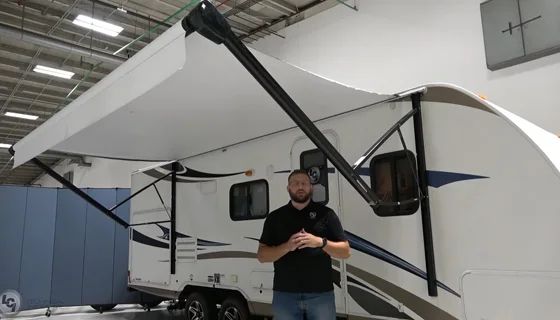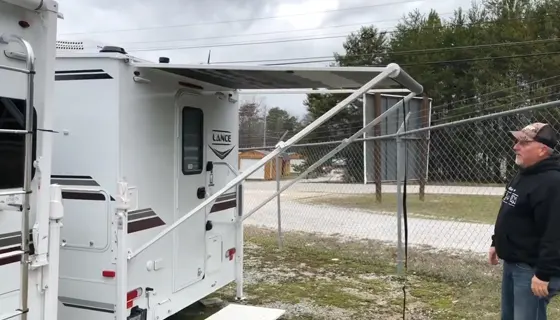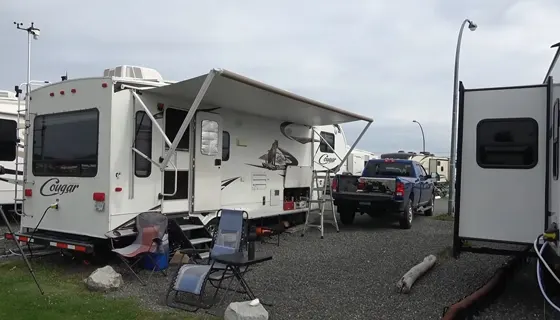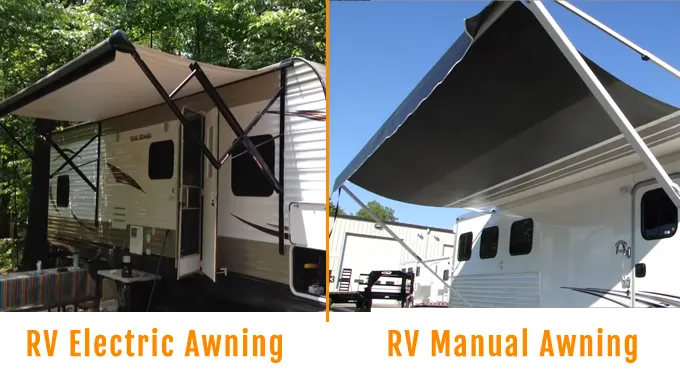Last Updated on April 15, 2023
An awning is essential for every camper, and it comes in two types: electric and manual. How your camping experience will go largely depends on what covers you.
They extend your living and recreational space by protecting you from UV rays and rain. We’re going to break down the pros and cons of an electric awning vs manual to get the best camping experience for you.
Without this tool, you’ll be reduced to camping inside your RV, which can get very claustrophobic, especially if you have kids with you. So you must carry one whether you’re driving a pop-up camper or a bus conversion.
What is an RV Electric Awning, and How does it Work?

An electric awning is a great way to add some extra shade and protection from the elements to your recreational vehicle. These shades typically attach to the side of an RV and can be extended and retracted using an electric motor and switch.
Many of them even come with LED lights for entertaining at night. A few newer models even have sensors that can automatically extend the awning when the sun comes out or retract it when windy conditions are detected.
So how do these retractable awnings work? They are operated by a switch or remote control. This sends a signal to the motor, which then extends or retracts the cover.
Advantages of an Electric Awning
Many campers choose electric awnings over the manual for the convenience they offer. Here are some of the benefits of using a motorized powered awning:
Safe to Operate:
An electric awning is also much safer to use than a manual one. Manual awning requires you to move the fabric to extend or retract it. The process can be difficult when the shade is wet or windy.
With an electric awning, all you have to do is push a button. When the frame and cover are retracted, it is automatically locked in place, preventing them from being blown open by the wind. This eliminates the risk of injuries from trying to fold or unfold a manual canopy.
Ease of Use:
Perhaps the most significant advantage is that it is much easier to use. With a manual awning, you have to physically push or pull the frame open or closed. This can be difficult, especially if the shade is large or if there is a strong wind.
With a motorized retractable awning, simply press the button, and it will retract automatically. Now you can open or close your awning even if you are not strong enough to do it manually. It is great if you have limited mobility.
Automatic Features:
Some electric awnings have automatic features that make them even more convenient to use. A wind sensor is a great example. This feature will automatically retract the shade if it detects that the wind is too strong.
There are models that have a temperature sensor that will automatically extend the retractable awning when it is sunny and retract it. This is a fantastic safety feature that can protect your fabric from damage.
Remote and Bluetooth Control:
Remote control or Bluetooth app operation are two of the main advantages of an electric retractable awning. With remote control, you can open and close your sunshade from inside your home or office, with no need to go outside in the heat or cold.
And with Bluetooth control, you can operate it using your smartphone or tablet. This is a great feature if you would like to open it before you arrive home so that it’s all set up and waiting for you. You can also use it to close your tent if you forget to do it before you leave.
Aesthetically Pleasing:
Motorized retractable awnings look cool for adding curb appeal to your RV home. Traditional sunshades can be unsightly with their metal frames and fabric panels.
Electric one features sleek aluminum frames and clear PVC panels. It can be installed without support posts, giving your home a cleaner look.
The awning arms are usually hidden away when not in use. They are available in a variety of colors and styles, so you can find an option that complements your home’s existing design.
Secure:
Electric awnings are also very secure compared to manual ones. They can be locked in place, which stops anyone from being able to open or shut the canopy without your permission.
When it’s extended, it creates a barrier between your outdoor space and the rest of the world. That barrier can be an important layer of security, especially if you’re in a crowded campground or if you have valuable items in your RV.
Durable:
Most motorized retractable awnings are made from durable materials. The fabric is often made from sturdy acrylic or polyester, and the frame is typically made from aluminum or steel.
This combination of strong materials makes them the strongest type of canopy you can find. They are often treated with UV-resistant and water-repellent finishes, which further increase their lifespan.
LED Lights:
Some electric awnings come with included LED lights, which help to extend your outdoor fun into the evening hours. They use far less electricity than traditional incandescent bulbs, so they’ll help to keep your electric bills low. Plus, they have a long lifespan, so you won’t have to worry about replacing them very often.
The lights can be used to illuminate a seating area or outdoor kitchen, making it easier to see and enjoy your surroundings. In addition, the lights can help to deter insects, providing you with an enjoyable and bug-free experience.
Awning Angle is Adjustable:
You can adjust the awning angle to get just the right amount of sun or shade. For example, on a hot day, you can angle the cover to provide extra shade, while on a cool day, you can open the shelter wider to let in more sun.
Some people like to have their sunshades positioned so they can enjoy the view while others prefer to remain private. And, with the push button, you can easily do it.
Easy to Install:
These awnings are easy to install. They come with all the hardware you need for installation, so all you need to do is follow the instructions included in the kit.
You will need to locate a suitable location to install a motorized powered awning. Then, use the mounting brackets that come with the product to secure it to the RV wall or eaves of your house. Connect the electrical wiring to an outlet that is controlled by a switch. Test the device by opening and closing it several times.
Dump Rainwater Automatically:
An electric awning can automatically dump rainwater when it becomes saturated. When it starts to rain, the sensors on the kit will detect the moisture and open it slightly to allow the water to run off. Then, when the rain stops, it will close again.
It prevents the fabric from becoming overloaded and collapsing. Its drainage system also helps to keep it clean and free of debris. So you won’t have to concern yourself with manually dumping the water. However, this feature is especially useful if you live in an area with frequent storms or heavy rain.
Lightweight and Compact:
Their compactness helps to take up very little space When you’re not using them. This makes them ideal for small patios, decks, or balconies where every square inch counts.
When you do want to use them, simply extending or rolling them out takes just seconds. If you need to take it off for any reason, an electric awning is very easy to remove for its lightweight design. This is in contrast to traditional shades, which can be bulky and difficult to store.
Drawbacks of an Electric Awning
Although electric awnings offer many benefits, there are also some drawbacks that you should be aware of.
Expensive:
Electric awnings are priced higher than manual models. The reason for this is that they require an electrical outlet to run, which means that they need to be installed by a qualified electrician. In addition, they typically have better features than manual models, such as LED lights and wind sensors.
While these features may add to the cost of the awnings, they also add to the convenience and safety of using them. Overall, they may cost more upfront.
Need Additional Maintenance:
The maintenance of electric awnings tends to be more extensive than that of conventional ones. This is because they have many moving parts, so there’s a greater chance of something going wrong.
They also require periodic cleaning and inspection to prevent damage from dirt and debris buildup. If one of the parts breaks, it can be difficult to replace it yourself. And if this patio awning gets damaged, it will likely need to be replaced entirely.
Needs Electricity:
They need electricity to operate, while manual shades can be operated without any power. You need to use 12-volt batteries or an electrical hookup to power them. It is necessary to provide power to the retractable motor in order for it to open and close.
The wind sensor requires current for proper operation. Many models are equipped with LED lights. You will need electrical power for them to run, so they can light up your outdoor space.
Noisy:
Electric shades can also be quite noisy because they rely on a motor for opening and closing the awning fabric. This motor needs to be strong enough to overcome the resistance of the wind and the weight of the fabric. Therefore, it must be relatively powerful.
They have moving parts. All of these parts need to be well-lubricated in order to reduce friction and prevent damage, but this lubrication can increase noise levels.
If the kit is not installed correctly, it will rub against the side of your house and create a lot of noise. It uses weather-stripping to seal any gaps around the cover. This will help to reduce the amount of air infiltration and, as a result, the amount of noise that is produced.
What is an RV Manual Awning, and How does it Work?

Manual models are hand crank operated awnings that are designed for RVs. They typically have a steel or aluminum frame and canvas or vinyl fabric.
The manual crank is used to open and close the kit. An RV manual retractable awning also has an adjustable pitch, which allows you to angle it to provide more or less shade. With the articulated arms on the frame, the arms extend when you unroll them.
You simply pull on the fabric until it is completely rolled up. Then, you can release the articulated arms, which will collapse back into place. This design makes it easy to operate a camper awning, even if you are not particularly strong or agile.
Advantages of Using an RV Manual Awning
RVs are a wonderful way to see the country and enjoy the outdoors, but they can also be a lot of work. One way to make life on the road a little easier is to invest in a manual awning for your travel trailer. These benefits include:
No Electricity Required:
There is no need for electricity, so it can be used even in remote locations. These awnings are operated by cranking a handle, which then opens and extends the frame. To close it, simply roll it up by pulling the fabric.
When the arms are released, it collapses completely. You don’t have to worry about finding a power source for it. And if there’s a power outage, you can still use your manual awning without any problem.
Multiple Angle Settings:
The angle of your awning can have a significant impact on its lifespan. By having multiple settings, you can adjust the canopy to provide the perfect amount of shade, no matter what the sun is doing. If the sun is high in the sky, you can tilt the shade to block out the glare.
Conversely, if it is lower down, you can move the shade to let in more light. Additionally, with various angles, you can make sure that your RV awning provides maximum protection against the weather, whether you are camping in a windy spot or facing severe weather conditions. Ultimately, it gives you better control over it and lets you customize it to suit your needs.
Electrically Convertible:
You might want to convert your RV awning to an electric model. Because of being tired of cranking the handle each time you use it, or maybe you want to be able to operate the device from inside the RV.
Whatever the reason, your RV should have enough battery power to run the system. If not, an electrical converter will be needed. Choose an electric shade that is compatible with the RV’s existing mounting brackets. There is also an electrically convertible kit available. Read the instructions carefully before beginning the conversion process.
Affordable:
A manual awning is less expensive than an electric one. Because it is manual, it does not require electricity for it to work. As they are not motorized, they require fewer materials and effort to make.
Their lack of sensors and switches allows them to be comparatively affordable. There are different grades of fabric for manual shades. Although these materials have different price tags, most of them are cheaper than a motorized model.
Disadvantages of Using an RV Manual Awning
While a manual awning can provide much-needed protection and shade, there are some disadvantages to using it.
Require Some Effort:
These awnings typically require two people to install, as they must be attached to the RV with screws or bolts. In addition, they must be tensioned correctly in order to work properly. This can be difficult to do without the assistance of another person.
They require some effort during opening and closing, which is cranked by hand. When you want to close it, you may have to unscrew the arms to fold it up correctly.
Need Storage when Unused:
Since manual awnings are often larger and less heavy-duty than their electric counterparts, they are sometimes tricky to store. Many RV owners find that they need to invest in dedicated storage space, such as a shed or garage to keep their kits safe from the elements when it is not in use.
Additionally, they generally require more upkeep than motorized awnings, as they need to be regularly cleaned and lubricated to prevent jams.
Time Consuming to Set Up:
Setting up this manual awning can be time-consuming, especially if you don’t have a helper. One reason why it takes longer to set up is that you have to secure each end of the connection to the RV.
If you are setting this sunshade up yourself, securing the cords can be challenging. In addition, ensure it is level and tight so that it doesn’t flap in the wind. It requires that you crank it out, which can take a few minutes.
Extended Armature:
The extended armatures can add significant weight to the awning, which is difficult to operate. They can interfere with the sealing, allowing water and debris to enter. Also, they can increase the wind resistance of a canopy, making it more likely to collapse in strong winds.
It can be a head-bumper if you’re not careful. You have to retract the shade completely before driving off. Otherwise, you risk damaging the armature or, worse, causing an accident.
Less Rugged:
Manual awnings are less rugged because they’re typically made with lower-quality materials. For example, they are made with thinner, less durable fabric that’s more susceptible to tearing. Additionally, they often have weak hardware, such as pulleys and brackets, that are prone to break or become damaged.
These RV awnings don’t have automatic roll-up or wind-sensing features. They require additional care and maintenance. Clean and lubricate them regularly to prevent damage caused by dirt, dust, and debris.
RV Electric Awning VS Manual Awning: Which Type is the Best for You?

Now that you know a little more about manual and electric awnings let’s compare them side-by-side to see which one is right for you. It really depends upon your individual tastes and needs.
If you’re looking for an RV awning that is easy to use and doesn’t require much effort to set up, then an electric model is the way to go. On the other hand, when looking for a sunshade that is less expensive and you don’t want to use electricity, then a manual one is your best bet.
Overall, electric awnings have many advantages over manual types. We recommend selecting a motorized system if possible.
FAQs:
Q: Can You Replace Electric RV Awning Manually?
Depending on the model of your RV, it may be possible to replace the motorized awning. However, you should consult your RV’s owner’s manual or a qualified RV technician to determine if this is possible with your particular model.
You have to remove the old one by disconnecting the power supply and manually lowering it. Start by attaching the brackets that will support the new unit. Extend the new frame and cover and secure it in place.
Q: Can You Convert a Manual Awning to Electric?
If you’re considering converting your manual model to an electric one, ensure that your model is compatible with an electric conversion kit. Check the manufacturer’s specifications to be sure.
You’ll need to install the conversion kit. This typically involves attaching brackets to the structure’s frame and connecting wires to a power source. Once the kit is installed, you’ll be able to operate it.
Q: Are Electric RV Awnings Spring Loaded?
No, electric RV awnings are not spring loaded. They are opened and closed by a roller tube that is driven by a motor. The roller tube is made of aluminum or steel, and it is attached to the retractable arm with brackets. When the motor is turned on, the chain turns the roller tube, which opens or closes the shade.
Q: How Much Wind Can an Electric RV Awning Take?
The answer depends on the specific model. Most electric RV awnings can withstand 32-40 km/h (20 to 25 mph). If you’re concerned about strong winds, it’s best to err on caution and purchase a sunshade with a higher wind rating.
Heavy-duty fabrics, such as vinyl or acrylic, will also stand up better to strong gusts than lighter-weight fabrics like polyester. That way, you can rest assured that your tent will stay put.
Final Thoughts
When you doubt which retractable RV awning to choose for your RV, this guide can help you. Our comparison between RV electric awning vs manual awning has hopefully made it easier for you to understand the difference and make a decision.
We found that electric sunshades are safer, durable, and energy-efficient. They’re also easier to install. However, they are more expensive and require frequent maintenance. These camping awnings are also dependent upon electricity to operate.
Manual awnings cost you less money. But they are harder to operate and don’t last as long. In the end, it all comes down to your personal preferences. If you have any questions, please don’t hesitate to contact us.



